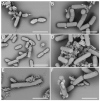Killing Effect of Bacillus Velezensis FZB42 on a Xanthomonas Campestris pv. Campestris (Xcc) Strain Newly Isolated from Cabbage Brassica Oleracea Convar. Capitata (L.): A Metabolomic Study
- PMID: 34210064
- PMCID: PMC8303752
- DOI: 10.3390/microorganisms9071410
Killing Effect of Bacillus Velezensis FZB42 on a Xanthomonas Campestris pv. Campestris (Xcc) Strain Newly Isolated from Cabbage Brassica Oleracea Convar. Capitata (L.): A Metabolomic Study
Abstract
The potential use of Bacillus velezensis FZB42 for biological control of various phytopathogens has been documented over the past few years, but its antagonistic interactions with xanthomonads has not been studied in detail. Novel aspects in this study consist of close observation of the death of Xanthomonas campestris pv. campestris cells in a co-culture with B. velezensis FZB42, and quantification of lipopeptides and a siderophore, bacillibactin, involved in the killing process. A new robust Xcc-SU isolate tolerating high concentrations of ferric ions was used. In a co-culture with the antagonist, the population of Xcc-SU was entirely destroyed within 24-48 h, depending on the number of antagonist cells used for inoculation. No inhibitory effect of Xcc-SU on B. velezensis was observed. Bacillibactin and lipopeptides (surfactin, fengycin, and bacillomycin) were present in the co-culture and the monoculture of B. velezensis. Except for bacillibactin, the maximum contents of lipopeptides were higher in the antagonist monoculture compared with the co-culture. Scanning electron microscopy showed that the death of Xcc-SU bacteria in co-culture was caused by cell lysis, leading to an enhanced occurrence of distorted cells and cell ghosts. Analysis by mass spectrometry showed four significant compounds, bacillibactin, surfactin, fengycin, and bacillomycin D amongst a total of 24 different forms detected in the co-culture supernatant: Different forms of surfactin and fengycin with variations in their side-chain length were also detected. These results demonstrate the ability of B. velezensis FZB42 to act as a potent antagonistic strain against Xcc.
Keywords: Bacillus velezensis FZB42; Xanthomonas campestris pv. campestris; antagonism; cyclic lipopeptides; killing effect; metabolomic analysis; siderophore.
Conflict of interest statement
The authors declare no conflict of interest. The funders had no role in the design of the study; in the collection, analyses, or interpretation of data; in the writing of the manuscript, or in the decision to publish the results.
Figures




References
-
- Liu K., Garret C., Fadamiro H., Kloepper J.W. Antagonism of black rot in cabbage by mixture of plant growth-promoting rhizobacteria (PGPR) BioControl. 2016;61:605–613. doi: 10.1007/s10526-016-9742-3. - DOI
-
- Bhattacharyya P.N., Goswami M.P., Bhattacharyya L.H. Perspective of beneficial microbes in agriculture under changing climatic scenario: A review. J. Phytol. 2016;8:26–41. doi: 10.19071/jp.2016.v8.3022. - DOI
-
- Monteiro L., Mariano R.L.R., Souto-Maior A.M. Antagonism of Bacillus spp. against Xanthomonas campestris pv. campestris. Brazil. Arch. Biol. Technol. 2005;48:23–29. doi: 10.1590/S1516-89132005000100004. - DOI
Grants and funding
LinkOut - more resources
Full Text Sources
Molecular Biology Databases
Miscellaneous

